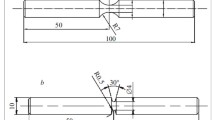Abstract
Shot-peening effects on the fatigue life behavior of bearing steel (JIS SUJ2) have been investigated. Hourglass-shaped test specimens were heat-treated and then surface-treated using a shot-peening machine. Results of a rotary bending fatigue test showed that shotpeening suppressed not only much of the surface-originated fracture but also the scattering error of the probabilistic stress-life data, and improved the fatigue life by about 6 times through the load levels of the cyclic tests. Such large increase in fatigue life was driven by the following reasons: The increase of hardness in the skin caused the predicted fatigue limit stress to increase by 15%; fracture-initiating inclusions were distributed at deeper locations, experiencing low nominal stresses; and the increase in the fish-eye fracture size by an average of 180%.
Similar content being viewed by others
References
P. Zhang and J. Lindemann, Influence of shot peening on high cycle fatigue properties of the high-strength wrought magnesium alloy AZ80, Scripta Materialia, 52(6) (2005) 485–490.
K. Shiozawa and L. Lu, Very high-cycle fatigue behaviour of shot-peened high-carbon-chromium bearing steel, Fatigue & Fracture of Engineering Materials & Structure, 25(8–9) (2002) 813–822.
S. K. Cheng, S. H. Lee and S. C. Chung, Effect of the peening intensity by shot peening, Transactions of the KSME(A), 25(10) (2001) 1590–1596.
P. Zhang and J. Lindemann, Influence of shot peening on high cycle fatigue properties of the high-strength wrought magnesium alloy AZ80, ScriptaMaterialia, 52(6) (2005) 485–490.
S M. A. S. Torres and H. J. C. Voorwald, An evaluation of shot peening, residual stress and stress relaxation on the fatigue life of AISI 4340 steel, International Journal of Fatigue, 24(8) (2002) 877–886.
Y. Murakami, Metal fatigue: Effects of small defects and nonmetallic inclusions, First ed. Elsevier Science Ltd, UK (2002).
JIS Z 2274, Method of rotating bending fatigue testing of metals.
ASTM, 1994, Standard test method for determining the effective elastic parameter for X-ray diffraction measurement of residual stress, ASTM E, 1426(94) (1994) 932–935.
KS B ISO 1143, Metallic materials — Rotating bar bending fatigue testing.
W. Li, T. Sakai, Q. Li, L.T. Lu and P. Wang, Reliability evaluation on very high cycle fatigue property of GCr15 bearing steel, International Journal of Fatigue, 32(7) (2010) 1096–1107.
J. Y. Lee, D. W. Jung and N. S. Choi, Fatigue fracture behavior and statistical life evaluation of hybrid composite/ metal beam-joints for a low-floor bus, Journal of Composite Materials, 46 (2011) on-line first.
D. C. Park, 2001, Electrical engineering probability, Intervision, Korea.
T. Sakai, Y. Satoand and N. Oguma, Characteristic S-N properties of high-carbon-chromium-bearing steel under axial loading in long-life fatigue, Fatigue & Fracture of Engineering Materials & Structures, 25(8–9) (2002) 765–773.
Y. Furuya, S. Matsuoka, T. Abe and K. Yamaguchi, Gigacycle fatigue properties for high-strength low-alloy steel at 100 Hz, 600 Hz, and 20 kHz, Scripta Materialia, 46 (2002) 157–162.
Author information
Authors and Affiliations
Corresponding author
Additional information
Recommended by Editor Jai Hak Park
Sang-Jae Yoon received his Master’s degree from the Department of Mechanical Engineering, Hanyang University, Korea, 2011. His research interests are fatigue fracture and material design.
Nak-Sam Choi received his Ph.D. from Kyushu University, Japan, 1990. He is currently a full professor in the Department of Mechanical Engineering, Hanyang University, Korea. His research interests include the fatigue behavior of materials and composites, acoustic emission analysis, experimental methods for composites and reliability analysis.
Rights and permissions
About this article
Cite this article
Yoon, SJ., Park, JH. & Choi, NS. Fatigue life analysis of shot-peened bearing steel. J Mech Sci Technol 26, 1747–1752 (2012). https://doi.org/10.1007/s12206-012-0340-8
Received:
Revised:
Accepted:
Published:
Issue Date:
DOI: https://doi.org/10.1007/s12206-012-0340-8




